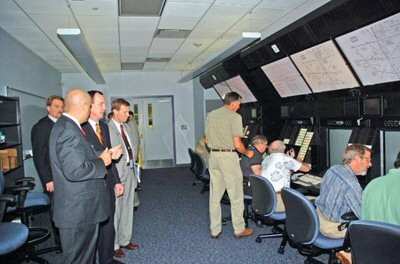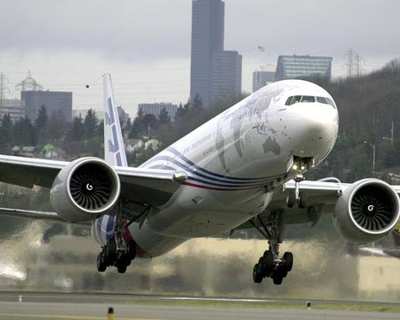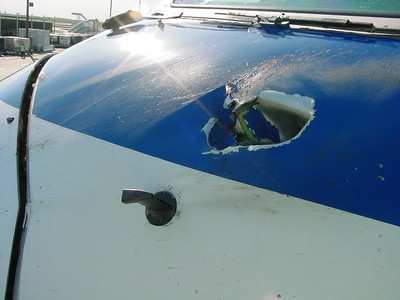Changes Would Save Time, Fuel
The Air Transport Association, the lobbying group for the major
United States Part 121 airlines (passenger and cargo), has long
been the authoritative voice of the airline industry. In the ATA's
latest briefing on the contentious fuel issue, the organization
mentions several potential ATC changes that might lead to time and
fuel savings.

The slide begins by praising the 2005 introduction of RVSM as an
example of the sort of procedural improvement that can save gas and
increase system capacity while maintaining an equivalent level of
safety. RVSM, Reduced Vertical Separation Minimums reduces
mandatory vertical separation between flight levels 290-410
(inclusive) from 2,000 feet to 1,000 feet, providing a theoretical doubling of traffic
throughout.
Are there more potential gains to be found in the system? The
ATA thinks so.
Here's ATA's list -- with a little of ATA's expanding text, and
our comments. Due to the amount of information involved, we've
split this into two parts. Today, we look at ATA's wish for
the FAA to expand the deployment of RNAV at major airports...
as well as for the agency to reconsider the current 250-knot "speed
limit" below 10,000 feet MSL.
On Thursday, we'll look at some of the ways ATA proposes to
reduce delays and holding times, and we'll offer our summary of the
situation.
The Wish List
- Accelerate RNAV deployment at hub airports; delegate
development of procedures. RNAV (Area Navigation)
provides more lateral freedom, so that airplanes use the whole
sky instead of the narrow, constricted pipelines of airways and
jetways.
ANN Take: Presumably they're talking about a
terminal version of Free Flight, or at least a greater number of
arrival/departure corridors for transport aircraft; with
development of the procedures offloaded to the individual lines or
their contractors. (Already, at present, an operator can develop a
Required Navigation Performance procedure of his own and staff it
through FAA). Real RNAV capability is a lot more widespread in GA
than in the airline fleet at present, but ATC seems to be slow on
the uptake. What's been holding it back, of course, is the
airlines' reluctance to embrace this technology. Flying from beacon
to beacon like Slim Lindbergh on the mail run in 1925 needs to die.
But having aircraft traveling at arbitrary altitudes and speeds, in
arbitrary directions, is going to tax controllers -- and their
computers.

And then, there's the effect on reliever airports -- which in
turn reflects back on the air carrier fields. Given that many
reliever airports are in close proximity to air carrier airports,
and separation of approach and departure paths to reliever airports
depend on the air carrier airplanes flying through distinct arrival
gates, the possibility exists that this proposal would increase
throughput at air carrier facilities at the expense of IFR capacity
at nearby reliever airports. This in turn is one of the few
scenarios where the hoped-for explosion of VLJ traffic in and out
of relievers would have a noticeable impact on air carrier
operations in the terminal environment. Imagine an Atlanta metro
area where traffic into KATL does not adhere to current routings,
but overflies the very busy reliever airports at low altitude.
No question that GPS can make for routings and fuel savings for
air carrier airplanes, but there would likely still need to be some
level of SID/STAR routings to deconflict with GA traffic at
outlying airports. At least with GPS there could be many more
transport corridors than a ground-based navigation system
provides.

- Reconsider rule limiting speeds below 10,000 feet to 250
knots; some aircraft may operate more efficiently at higher speeds
(especially on climb-out) but are prevented from doing so (note:
also allows controllers greater flexibility to manage air
traffic)
ANN Take: One reason for this reg (FAR
91.117(a)) is that, at higher speeds, see-and-avoid isn't
practical, as a couple of well-known accidents where military
aircraft centerpunched loitering GA machines have illustrated. ATA
tends to assume that their birds are the only ones in the sky; it
ain't necessarily so. The basic problem is one of deconfliction
with aircraft that are not in the system; deconfliction with IFR
aircraft appears to pose no problems.

If that hurdle could be overcome, lifting this limit would be a
benefit to airline and to business jet operators (especially as
newer, faster jets come online in the next two decades). It would
drive Boeing and Airbus wild with frustration because their latest
planes are designed with this limit in mind, and might have been
more efficient without it.
From the GA point of view this remains an alarming proposal
without a way for participating aircraft to see and avoid
nonparticipating aircraft. We're keenly aware that in a GA-airline
midair, the finger of blame points to GA even when the airliner's
CVR reveals the crew yukking it up about having lost sight of the
Cessna they're about to hit. (Not that there isn't usually enough
blame to go around in any of these crashes). The inability of the
military to completely prevent even F-16s and Tornados, whose
onboard radar detects even non-transponder aircraft, from the
occasional midair is not encouraging about a future filled with
airliners traveling at 300+ knots without such equipment.
See-and-avoid is the basis of aircraft separation even for IFR
airplanes when in Visual Meteorological Conditions. See-and-avoid
permits a much greater airport capacity for air carrier aircraft
when conditions are VMC -- picking on ATL again, think about
airline flight delays any time it's even marginal VFR at the
airport. Depending on IFR separation requirements at all times to
permit higher speeds would condemn air carrier airports to their
low-capacity modes all of the time, not just when weather is
poor.
Finally, birds (birds in the literal sense) never file IFR and
don't carry transponders, and civil aircraft windshields are not
certified for bird strikes at high speeds (or multiple-bird strikes
for that matter). While birdstrike safety certification standards
have resisted worldwide harmonization, US standards are relatively
close to those of other authorities. FAA tests to 250-280 knots,
the Air Force to 550 knots. The speed limit rule was imposed in
North America for the principal purpose of bird-strike safety, and
a thorough 2005 study in Canada presented data supporting the
retention of the limit.

"[A] 20 percent increase in aircraft speed from 250 to 300 KIAS
results in a 44 percent increase in impact energy during a bird
strike," the authors summarized. "Clearly the speed of the aircraft
and engine rotation speed are more important in a collision than
the size of the bird and more controllable than the size of the
bird." (.pdf here). The study notes that a
previous FAA experimental study of higher speeds in Texas in 1998
was cut short as unsafe. That document contains some chilling
stories of bird strike damage, casualties and near-casualties.
As proposed here, then, the ability to operate at unrestricted
speed benefits the airlines by increasing on-time performance for
late-launched flights, and may provide some fuel
savings. Until a near-foolproof system for avoiding bird
strikes is incorporated, however, those changes may come
at the expense of a probable increase in aircraft lost through
bird strikes and midairs.
We think that if you asked the passengers on those doomed
aircraft, they'd pay a few dollars more in order not to die.
 Aero-News: Quote of the Day (04.28.25)
Aero-News: Quote of the Day (04.28.25) ANN's Daily Aero-Term (04.28.25): Decision Altitude (DA)
ANN's Daily Aero-Term (04.28.25): Decision Altitude (DA) ANN's Daily Aero-Linx (04.28.25)
ANN's Daily Aero-Linx (04.28.25) Airborne-Flight Training 04.24.25: GA Refocused, Seminole/Epic, WestJet v TFWP
Airborne-Flight Training 04.24.25: GA Refocused, Seminole/Epic, WestJet v TFWP Aero-News: Quote of the Day (04.29.25)
Aero-News: Quote of the Day (04.29.25)







